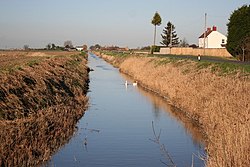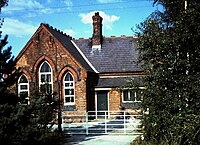North Forty Foot Bank
| North Forty Foot Bank | |
| Lincolnshire | |
|---|---|
 North Forty Foot Drain | |
| Location | |
| Grid reference: | TF249477 |
| Location: | 53°-0’44"N, 0°8’19"W |
| Data | |
| Post town: | Boston |
| Postcode: | PE20 |
| Dialling code: | 01205 |
| Local Government | |
| Council: | Boston |
| Parliamentary constituency: |
Boston and Skegness |
The North Forty Foot Bank is a long, thin hamlet which runs about six miles along the North Forty Foot Drain, about five to nine miles north-west of Boston in Holland, the south-eastern part of Lincolnshire.
The string of habitation begins just south of the parish of Chapel Hill and runs along the drain to Toft Tunnel, just north of Hubberts Bridge. Despite its length, it only consists of the area on the north side of the drain, which was built in 1720 by Earl Fitzwilliam.[1]
The North Forty Foot Bank forms the boundary between Harts Grounds and Pelhams Lands.
A row of 29 brick and slate cottages were built between the North Forty Foot Bank and the hamlet of Brothertoft by Major John Cartwright to accommodate the workers of his red brick woad mill in the late 18th century. This place was then called Isatica, which is Latin for "woad".[2] After Cartwright left Brothertoft for London, the hamlet of Isatica fell into ruin and disappeared.[3][4]
Formerly extra-parochial, the North Forty Foot Bank was created a civil parish in 1858, but in 1906 became part of the civil parish of Holland Fen with Brothertoft.[5]
Clumps or settlements within North Forty Foot Bank include:
- Pelhams Land
- Harts Ground
- Holland Fen
- Hedgehog Bridge
- Toft Tunnel
Hedgehog Bridge, about five miles north-west of Boston, on the North Forty Foot Bank, was named after a hump-backed bridge over the drain which no longer exists. Hedgehog Bridge School was built in 1880 by the North-East Holland Fen School Board for 95 children.[6] It opened on 4 April 1881, became a Council School in 1903, and a County School about 1947. It finally closed in December 1969, and was demolished in 2010.[7]
Toft Tunnel is at the junction of the North Forty Foot Bank and the B1192 Langrick Road. Today it consists mainly of farms.
Outside links
| ("Wikimedia Commons" has material about North Forty Foot Bank) |
References
- ↑ W. H. Wheeler (1868). "History Of The Fens Of South Lincolnshire". p. 44. http://babel.hathitrust.org/cgi/ptsearch?id=loc.ark%3A%2F13960%2Ft1xd1dh90;q1=%22north%20forty%20foot%22. Retrieved 6 May 2011.
- ↑ Bearstall, T. W.: 'Agricultural Revolution in Lincolnshire' (The History of Lincolnshire Committee, 1978) ISBN 0-902668-07-2; page 222
- ↑ Young, Arthur: 'General View of the Agriculture of the County of Lincoln' (Board of Agriculture, 1799)}
- ↑ Dispersed settlement of Brothertoft: Lincs to the Past
- ↑ Brothertoft on Vision of Britain
- ↑ "Kellys Directory 1919". Kellys Directories Ltd. p. 294. http://www.historicaldirectories.org/hd/d.asp. Retrieved 20 April 2011.
- ↑ Brothertoft Hedgehog Bridge County Primary School: Lincs to the Past

